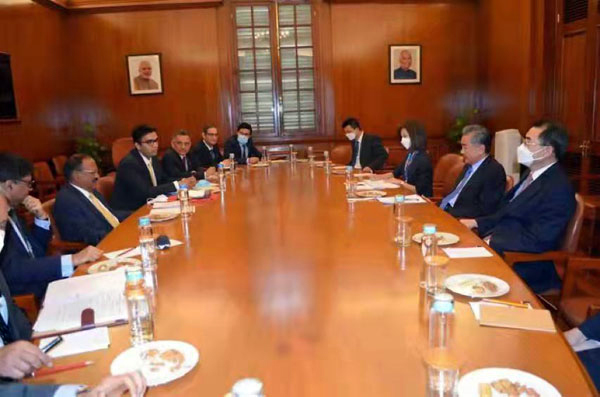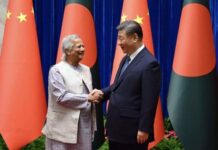
Maj Gen Deepak K Mehta
Chinese foreign minister Wang Yi visited New Delhi on 25 March 2022, the first by a top Chinese official after the 2020 clashes. Neither Beijing nor New Delhi made an official announcement about Wang’s visit.
That Wang chose to visit was a surprise, that India agreed to the visit was a bigger one. The visit was considered a diplomatic breakthrough given the slump in bilateral ties since the standoff in Ladakh started in 2020.
Speaking after the visit, Jaishankar no time line was agreed upon for disengagement and de-escalation along the Line of Actual Control (LAC). A parallel but a separate discussion took place in regard to sorting out the situation in border areas. He said 15 rounds of talks were held between the Corps Commanders of the two Armies since April 2020 leading to some progress at several friction points.
Wang at OIC
Wang’s visit to New Delhi came just a day after his comments on Jammu and Kashmir at an Organisation of Islamic Cooperation (OIC) meeting in Islamabad, Pakistan, managed to irk New Delhi.
At the OIC meeting before leaving for New Delhi, Wang said: “On Kashmir, we have heard again today the calls of many of our Islamic friends. And China shares the same hope.”
This drew a sharp reaction from the Ministry of External Affairs. The MEA spokesperson said: “We reject the uncalled reference to India by the Chinese Foreign Minister Wang Yi during his speech at the Opening Ceremony (of the OIC meeting).”
“Matters related to the Union Territory of Jammu & Kashmir are entirely the internal affairs of India. Other countries, including China, have no locus standi to comment. They should note that India refrains from public judgement of their internal issues,” he said.
Delegation-level Talks
National Security Advisor (NSA) Ajit Doval told Wang Yi that there was a need to push for early and complete disengagement at the LAC for bilateral ties to return to their natural course.
During delegation-level talks at the South Block in the national capital, India made it clear that continuation of the present situation was not in mutual interest.
The Chinese side invited NSA Doval to visit China to take forward the mandate of Special Representatives on border issues. Doval responded positively to the invitation and said that he could visit after immediate issues are resolved successfully.
Disengagement Proposal Rejected
The Indian Express reported that around the time of Wang’s visit, China had sent a proposal for disengagement of troops from Patrolling Point 15 in the Hot Springs area of eastern Ladakh.
“Government sources said China proposed that Indian troops, who have been in an eyeball-to-eyeball confrontation with Chinese troops at PP 15 for almost two years now, move back to the Karam Singh Post between PP 16 and PP 17. China said it would withdraw its troops just behind the Line of Actual Control (LAC) as claimed by India in that region,” the newspaper reported.
The proposal was rejected since the Chinese claim line and India’s understanding of the LAC almost intersect at PP 15. If India were to accept the proposal, it would mean that while Chinese troops would move back very little, Indian troops would have to withdraw several kilometres even behind PP 16 which has never been claimed by China earlier.
State of India-China relations
Thousands of Indian troops remain deployed along India’s remote border with China in the Himalayan snow deserts of Ladakh, where hand-to-hand fighting broke out in June 2020.
At least 20 Indian and four Chinese soldiers were killed during a clash in Ladakh’s Galwan valley – the first deadly encounter between the nuclear-armed neighbours in decades.
Their undemarcated 3,500-km-long frontier has remained largely peaceful since a border war in 1962, and both countries still claim vast swathes of each other’s territory.
After the Galwan clash, senior officers from both militaries held more than a dozen rounds of talks to de-escalate the standoff in Ladakh but progress has been limited.
Last February, after multiple military parleys, Indian and Chinese troops completed a pullout from a lake area in Ladakh. Days later, Chinese foreign minister Wang Yi and his Indian counterpart S. Jaishankar agreed to setup a hotline.
There has been little progress for disengagement from the Depsang Plains in north Ladakh. The Chinese have denied Indian troops access to their traditional patrolling points 10, 11, 11A, 12 and 13 but the Chinese have moved machinery for roadbuilding behind these patrolling points.
A total of 15 rounds of talks has been held at the level of corp commanders between the two armies on disengagement from various parts of Ladakh. But progress has been slow.
Beijing has repeatedly said that border standoff does not represent the entirety of China-India relations, while New Delhi has maintained that peace along the frontier is essential for the two countries to work together.
New Delhi has numerous other concerns regarding China’s activities in almost all of India’s neighbours.
Aside from the tensions in the Himalayas, India’s mistrust stems from Beijing’s support of old foe Pakistan, the competition for influence in Nepal, and concern over China’s economic clout in Bangladesh, Myanmar and Sri Lanka.
Chinese Strategy
Unsettling signal from China show that it intends to continue the ‘string of pearls’ strategy to encircle India in South Asia.
By engaging with Afghanistan’s ruthless regime for rare earth and minerals, China is trying to use a vacuum where India has almost no leverage. Sri Lanka and Nepal’s infrastructure investments aim to cut India’s regional standing. Deep seaports in Myanmar extend that envelope. This is a strategy of boxing India in and flies in the face of Wang Yi’s assertion during his meetings in Delhi that China does not seek a unipolar Asia.
Defence Spending
The standoff in the high Himalayas is a costly undertaking. India is not walking the talk with its defence spending. China increased its defence budget by 7.1 per cent to $230 billion in 2022. It is three times that of India’s $70 billion in 2022.
Without spending at the very least three per cent of her GDP on defence, India will find it increasingly difficult to match China’s assertiveness on the borders.
Economic Lever
In the two years of the standoff, India’s trade deficit is a staggering $103 billion in China’s favour. The quality of this trade deficit is also startling. India exports primarily iron ore, aluminium, and agricultural commodities while importing finished products across consumer and industrial categories, like electronics, pharmaceuticals, fertilisers, and infrastructure items from Beijing.
The trade lever is firmly in China’s hands. Apart from banning a few apps, Narendra Modi’s government has been unable to bring structural reforms over two years to dent this relationship.
Investment and App Bans
China is India’s largest trading partner, with bilateral trade expanding exponentially since the turn of the century to $95.02 billion in 2021/22. Trade remains heavily tilted in Beijing’s favour. India’s trade deficit with China is the largest it has with any county, and the imbalance has been steadily widening.
More than 100 Chinese companies, including state-owned enterprises, operate in India, including electronics manufacturers that have come to dominate the country’s mobile phone market.
Since 2020, however, New Delhi has tightened the screws on Chinese players in Asia’s third largest economy by increasing scrutiny of investments or imports and banning some mobile apps.
The Indian government had previously held up investments worth billions from Beijing, but last week said that approvals for 66 proposals from neighbouring countries – including China – totalling $1.79 billion had been approved.
In February, India also blocked access to dozens of Chinese apps over security concerns, increasing the tally of such restricted mobile apps to more than 300.
Comments
The India-China relationship has been at its lowest point in three decades since Beijing tore up a decade’s worth of agreements for maintaining peace and tranquility at the border and sent troops into India’s side of the Line of Actual Control in eastern Ladakh in 2020.
If the Chinese intention was to gauge if India was ready to normalise ties, then the visit was structured inauspiciously. Wang, who is also a state councillor, arrived via Islamabad and Kabul. In Pakistan, he aired pro-Pakistan views on Kashmir at the foreign ministers’ conference of Organisation of Islamic Conference (OIC). In Afghanistan, he engaged the globally-slighted Taliban regime as it regresses to its old behaviour. A cold reception in New Delhi was thus expected. South Block judged correctly that the China’s obduracy required a riposte as the China’s need for de-escalation was now greater than India’s.
In 2017, China had similarly shown flexibility to resolve the Doklam stand-off after the BRICS meeting on the sidelines of the G-20 summit in Hamburg. Subsequently, not only China has dug deeper at positions near Doklam but showed no hesitation in widening the confrontation three years later in Ladakh.
The onus of normalisation of ties lies with Beijing. The presence of a large number of troops, in contravention of agreements, denotes an abnormality and is a clear signal that border disengagement and de-escalation remain non-negotiable for any restoration of ties.
No breakthrough or major announcement came out of Beijing’s outreach. The conversation in the Chinese Communist Party mouthpiece Global Times veered around the need for New Delhi to change its attitude and play down the border clashes for a positive thrust, given the two neighbours’ relations with Russia, a line taken by Wang Yi himself. Both Jaishankar and NSA Ajit Doval, though, responded to the call for taking a ‘long-term view’ by sticking to the stance that the overall development of ties was intrinsically linked to resolution of the border issues.
The new escalatory cycle now can be broken. India’s neutrality over Ukraine addresses Chinese worry about Indian proximity to the United States, after the Quad meetings were raised to the summit level. But China’s tactical moves must not be mistaken for a strategic shift. India will continue to be seen as a potential rival.

















